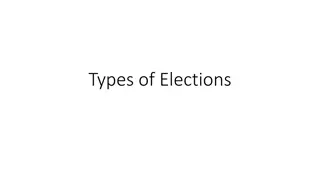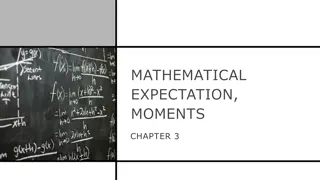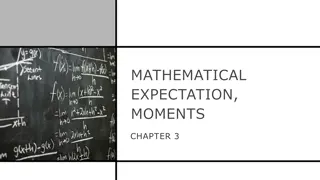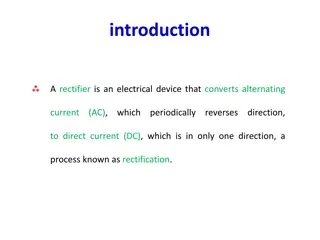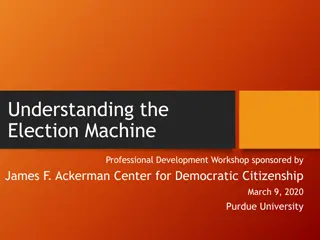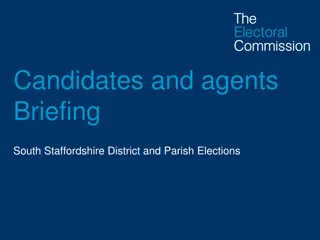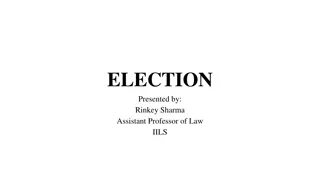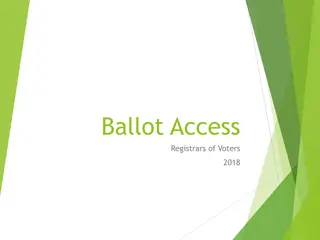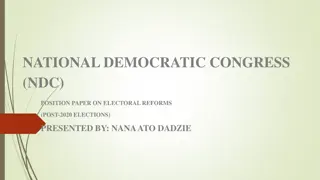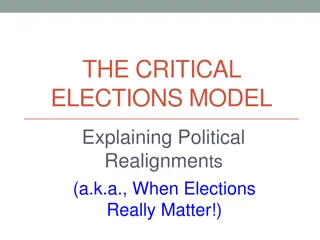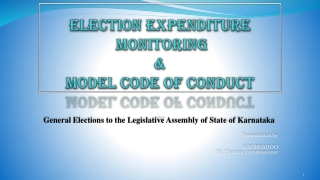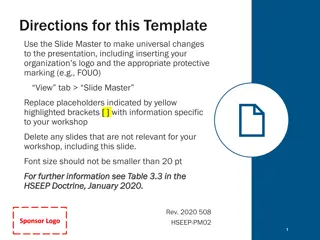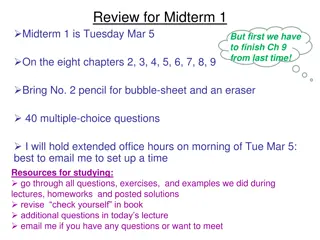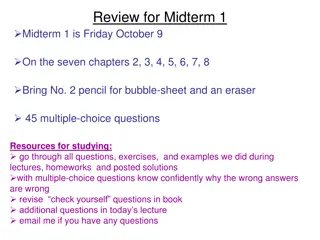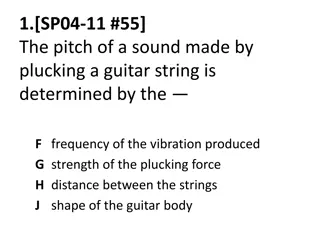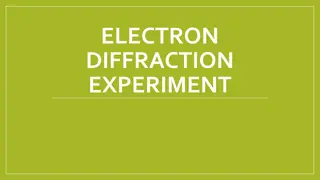Analysis of the 2022 Midterm Elections: Red Wave Expectation and Realities
Understanding the dynamics of the 2022 Midterm Elections, this analysis delves into the expectations of a Red Wave, reasons behind it, historical trends in house and senate elections, factors that influenced the outcome, and the impact of key issues like abortion and Trump's influence on the results.
Download Presentation

Please find below an Image/Link to download the presentation.
The content on the website is provided AS IS for your information and personal use only. It may not be sold, licensed, or shared on other websites without obtaining consent from the author. Download presentation by click this link. If you encounter any issues during the download, it is possible that the publisher has removed the file from their server.
E N D
Presentation Transcript
2022 MIDTERMS, LOOKING BACK AND BEYOND TCCTA CONVENTION, MARCH 3, 2023 Tom Patterson Kennedy School of Government, Harvard University
Why was a Red Wave expected in 2022? Political science theories: Surge and decline theory Referendum theory An overriding issue high inflation Public mood 70 percent of Americans thought the nation was heading in the wrong direction Based on past midterms, these factors suggested that Republicans would win a sweeping victory
The Midterm Tendency House Elections Loss/gain of House seats by president's party (1922-2018) 9 8 5 26 30 34 38 42 46 50 54 58 -4 62 66 70 74 78 82 86 90 94 98 2 6 10 14 18 22 -5 -8 -9 -9 -12 -13 -15 -18 -26 -28 -30 -40 -44 -48 -48 -48 -52 The out-party on average has picked up 28 House seats in the midterm, three times what Republicans picked up in 2022 -54 -55 -63 -72
The Midterm Tendency Senate Elections Loss/gain of Senate seats by president's party (1922-2018) 10 2 2 1 1 1 1 0 26 30 34 38 42 46 50 -1 54 58 62 66 70 74 78 82 86 -1 90 94 98 2 6 10 14 18 22 -3 -4 -4 -5 -6 -6 -6 -7 -8 -8 -8 -9 -9 -12 -12 The out party on average has picked u 4 Senate seats in the midterm, 5 more than Republicans in 2022
Explaining Why the Red Wave Didnt Happen 1. Abortion issue s impact on congressional races 2. Trump s impact on Senate races 3. The Big Sort s impact on House races
Congressional races The Abortion Issue
Enthusiasm Gap Early 2022 Percentage of respondents very or extremely enthusiastic about voting 61 58 49 48 mid-March Democrats Mid-June Republlicans Survey: Morning Consult-Politico polls
Enthusiasm Gap in Recent Midterms R+63 If the election had been held in mid-June, the enthusiasm gap would have predicted a Republican pick up of roughly 30 seats. For each election: Left bar is enthusiasm gap; Right bar is change in House seats D+40 D+30 R+16 R+15 R+13 D+11 D+8 2006 2010 2014 2018 Source: Gallup polls
Enthusiasm Gap - 2022 Percentage of respondents very or extremely enthusiastic about voting 61 57 58 56 49 48 Dobbs ruling mid-March mid-June mid-September Democrats Republlicans Survey: Morning Consult-Politico polls
2022 Exit Polls Democrats Feeling about Roe v. Wade being overturned percent of Democratic respondents Angry 70 Dissatisfied 21 Satisfied 8 Enthusiastic 1 Source: 2022 Exit polls
The Abortion Issue 2022 Exit Polls Most Important Issue to Your Vote Two-party vote by issue percentage of voters percentage pf voters 28 Inflation Inflation 31 71 76 Abortion Abortion 27 23 41 Crime 59 Crime 11 60 Gun policy 39 Gun policy 11 25 Immigration 73 Immigration 9 Democratic Republican Source: 2022 election exit polls
Senate Races Luck, and The Trump Factor
The Luck Factor Going into Election Day, Politico rated six Senate races as toss- ups. Democrats won 5 (Arizona, Georgia, Nevada, New Hampshire, and Pennsylvania) out of the 6, losing only to incumbent Senator Ron Johnson by 1 percentage point in Wisconsin. The statistical probability that Democrats would win 5 of 6 toss-up elections is 9%. The last such Senate election was in 1980, when Republicans won 7 of 7 toss-ups, enabling them to take control of Senate for first time since early 1950s. The odds of winning 7 out of 7 is 1%.
The Trump Factor Breaking with tradition for a former president, Donald Trump campaigned actively for the election of eight Republican Senate Republican candidates (Johnson, Wisconsin; Oz, Pennsylvania; Masters, Arizona; Walker, Georgia; Vance, Ohio; Budd, North Carolina; Laxalt, Nevada; Bolduc, New Hampshire). Five of the eight lost, including the flipped Pennsylvania Senate seat, leading pundits to claim that Trump cost Republicans control the Senate. But is there any evidence to support the claim? Was Trump a drag on these races and, if so, how big a drag?
Estimating the Trump Factor Republican Senate margins in 2016 and 2022 Average Republican Senate Vote Non-Trump states - 2016 54.2 In the non-Trump states, Republican candidates averaged 0.5 percentage points fewer votes in 2022 Non-Trump states - 2022 53.7 8 Trump states - 2016 53.6 In the 8 Trump states, Republican candidates averaged 4.6 percentage points fewer votes in 2022 8 Trump states - 2022 48.9 Note: Trump states are the 8 states where Trump was deeply engaged in the 2022 Senate races. Of non-Trump states, California and Alaska excluded from calculations because the 2016 and 2022 races are not comparable. In 2016, California s two general election candidates were Democrats as a result of the state s top-two primary system. In 2016, Alaska had a competitive 3-candidate race.
House races The Big Sort
Referendum Theory of Midterm Elections The Theory: After taking office, presidents typically make more enemies than friends because of their policies and national conditions, which leads to declining popularity that weakens appeal of president s party in midterms.
Change in Presidential Approval Rating from First Year in Office to Second Year Percentage change in presidential approval from year one to year two -2 Kennedy -8 Johnson Nixon -3 -28 Ford Carter -6 Reagan -13 GHWBush 12 Clinton -8 GWBush 22 Obama -12 Trump -9 -11 Biden Source: Gallup polls
Presidential approval rating and Out-Party Share of Midterm House Vote Nationally 70 Biden s approval rating predicted that Republicans would win 2022 national House vote by 52-48 65 60 Presidential approval rating 55 50 45 40 Biden 35 30 48 49 50 51 52 53 54 Out-party share of national House vote Note: Slope based on 1962-2018 midterms
Actual Nationwide House Vote in 2022 percentage of national House popular vote Percentage is nearly exactly what referendum theory predicted. Republican candidates 51.4 And yet, despite outpolling Democrats by nearly 3 percentage points nationally, Republicans gained only 9 seats instead of the roughly 25 seats the model would predict Democratic candidates 48.6
Out-Party Share of National House Vote and Out-Party Gain in House Seats 44 Republicans should have picked up 25-30 seats based on their predicted national popular vote margin based on Biden s approval rating. 31 Out-party gain/loss of House seats 22 11 5 0 -5 47 48 49 50 51 52 53 Out-Party Percent of National Vote based on president's approval rating
The Puzzle What might explain the fact that Republican House candidates nationwide had a roughly 3 percentage points edge in the national vote but picked up only 9 House seats?
Explaining the Republican Shortfall The Big Sort Over the past two decades, red states have gotten redder and blue states have gotten bluer. But the red states have gotten redder than blue states have gotten bluer. As a result, red states waste more votes than blue states.
Red State & Blue State House Vote in 2022 Two-party percentage of vote for House candidates 63.4 Red States 36.6 3.6% difference 40.2 Blue States 59.8 Republican Democratic NOTE: In constructing the chart, red states were AL, AK, AR, ID, IN, KS, KY, LA, NE, ND, MO, MS, OK, SC, SD, TN, TX, UT, WV, WY whereas blue states were CA, CT, DE, HI, IL, MA, MD, MN, NY, NJ, OR, RI, VT, WA. Some analysts would place CO and NM in the blue state category. If they had been included in the calculations, the Democratic percentage in the blue states would have been lower, widening the gap in wasted votes between red and blue states.
LOOKING AHEAD TO 2024 ELECTIONS
2024 SENATE AND HOUSE RACES In the end, the arithmetic is decisive. Arthur Schlesinger, Jr., historian & presidential advisor
The Arithmetic: Senate Races Of the 34 seats up in 2024 Democrats are defending 23 seats (nearly half of their Republicans are defending 11 seats (less than a fourth of their Senate majority) current members) To gain control of the Senate, Republicans need a net gain of 2 seats or only 1 seat if they win the presidency in 2024.
2024 Senate Races Democrats are defending 23 seats, Republicans 11 seats
The 8 Senate Seats Most Likely to Flip in 2024 Source: Vulnerable seats based on combined assessments of Cook Political Report, 538, and CNN.
The 8 Vulnerable Democratic Senate Seats 1. West Virginia Manchin trails Jim Justice by 10 points in most recent polls 2. Montana if Tester retires, Republican likely win; Tester could also lose even if he runs 3. Arizona if Sinema runs as Independent, the Democratic vote will be split. giving Republicans an easy win 4. Ohio Brown is running but Ohio is increasingly Republican 5. Nevada Rosen is running but it s a toss-up state 6. Wisconsin Baldwin is running but it s a toss-up state 7. Michigan open seat in a toss-up state 8. Pennsylvania Casey is running and looks the safest of the 8 but Pennsylvania is a toss-up state.
Competitive House Races in 2024, according to Cook Political Report Number of races by incumbent s party and whether toss-up or leaning 9 Toss-up district, Republic incumbent IN SHORT: Democrats are defending more competitive House seats 23-19 than Republicans Toss-up district, Democratic incumbent 11 9 Leans Republican district, Republic incumbent Leans Democratic district, Democrat incumbent 10 12
The Arithmetic: Democrats Chances of Retaking Control of House Democrats need to flip 5 seats 1. If Democrats were to retain all 23 of their toss-up/leaning districts, they would need to win 5 of the 19 Republican toss-up/leaning districts 2. For each Democratic toss-up/leaning district lost to Republicans, Democrats would need to pick an additional Republican toss-up/leaning districts 3. As of today, odds are that Republicans will retain control of the House
The Presidential Race as of this week percentage of 2-party vote Biden 49 Trump 51 To win an Electoral Vote victory, Biden would likely have to win the popular vote by 2-3 percentage points. Biden 49 DeSantis 51 Note: Percentages are average of most recent Harvard-Harris, Quinnipiac, and Reuters/ISPOS polls.
But this is early 2023, not November of 2024. What between now and then could tip the presidential election toward one party or the other? From political science studies, we know that one of the best predictors of whether the in-party will retain the presidency is the state of the economy in the election year.
The Economy and Presidential Election Outcome GDP and incumbent-party share of presidential vote
Two Elections to Consider 1980 & 1984 GDP and incumbent-party share of presidential vote Reagan s reelection bid Carter s Reelection bid
Will Biden be like Carter (1980 election)? average approval rating 61 Carter 54 45 38 38 43 Biden Year 1 Year 2 Year 3 Year 4
Or Will Biden be like Reagan (1984 election)? average approval rating 57 Reagan 56 54 43 43 45 Biden Year 1 Year 2 Year 3 Year 4
Timing Is (Nearly) Everything in Politics Reagan, if 1982 had been a presidential election year Reagan s reelection bid Carter s Reelection bid 1982
A Final Look Ahead at 2024 Democrats best scenario: If inflation substantially declines and employment stays high Biden should win easily, and Democrats should win most of the competitive House districts, enabling them to capture the House. Even so, the Senate could be out of reach. Republicans best scenario: If inflation stays high and the economy cools down GOP presidential candidate (Trump could be an exception if the nominee) wins the election, and Republicans easily control House and Senate.
Thank You Questions, Observations, Objections?




